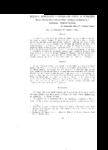Biología, morfología y evaluación tóxica de acaricidas en la araña roja de la fresa Tetranychus telarius (L) (Acarina: tetranychidae)

View/
Date
1968Author
Velasco P., Hermenegildo
Pacheco, Francisco
Metadata
Show full item recordAbstract
Se estableció un cultivo de ácaros Tetranychus telarius (L.) en invernadero, para tener una fuente de material biológico. El objeto fue llevar a cabo los estudios de biología, pruebas con acaricidas y tener material para estudios de morfología. Los ácaros se colectaron en cultivos de fresa en Irapuato y los resultados con acaricidas efectuados en el invernadero fueron comprobados en condiciones de campo. La biología de T. telarius comprende los estados de huevecillo, larva, protoninfa, deutoninfa y adulto, con duración sw 5, de 6 a 6.4, de 1.8 a 2.5, de 1.8 a 3.5 y de 2.4 a 5.0 días respectivamente. Timet, Etión y Clorobenzilato, resultaron ser los mejores acaricidas para el control de huevecillos, tanto recién ovipositados como viejos. Keltane, Metasystox y Fenkaptón, mostraron elevada toxicidad, aunque en menor grado para huevecillos de diferente edad. Los seis acaricidas mencionados resultaron muy tóxicos para los adultos tratados en el campo y en invernadero. ABSTRACT: The mite Tetranychus telarius L. was reared in the green-house as a source of biological material. The objective was to study its biology, its morphology and to observe the effect of different miticides. The original mites were collected in a strawberry field near Irapuato. Results with the miticides tried in the green-house were tested under field conditions. The life cycle of T. telarius includes the stages of egg, larva, protonymph, deutonymph and adult wich last respectively 5, 6 to 6.4, 1.8 to 2.5, 1.8 to 3.5 and 2.4 to 5.0 days. Thimet, Ethion and Chlorobenzilate were shown to be the best miticides for the control of eggs, recently laid and old. Kelthane, Metasystox, Fenkapton have a high toxicity although at the lower level against eggs of different ages. The six miticides mentiones were highly toxic to adults, both in green house and field applications.
Collections
- Agrociencia [55]
